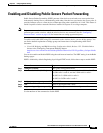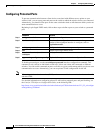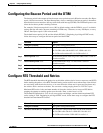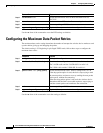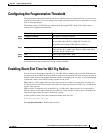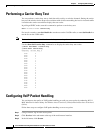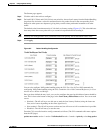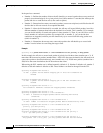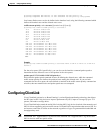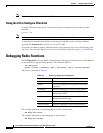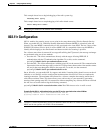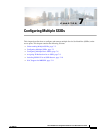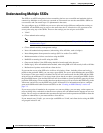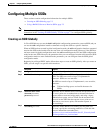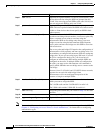
6-37
Cisco IOS Software Configuration Guide for Cisco Aironet Access Points
OL-30644-01
Chapter 6 Configuring Radio Settings
Configuring ClientLink
ap(config-if)#packet max-retries 3 0 fail-threshold 100 500 priority 6 d
ap(config-if)#packet max-retries 3 0 fail-threshold 100 500 priority 6 drop-packet
Low latency Packet rates can also be defined at the interface level, using the following command which
defines the nominal rates and the allowed rates to use:
traffic-stream priority value sta-rates {[nominal rates] | [rates]}
ap(config-if)# traffic-stream priority 6 sta-rates ?
12.0 Allow 12.0 Mb/s rate
18.0 Allow 18.0 Mb/s rate
24.0 Allow 24.0 Mb/s rate
36.0 Allow 36.0 Mb/s rate
48.0 Allow 48.0 Mb/s rate
54.0 Allow 54.0 Mb/s rate
6.0 Allow 6.0 Mb/s rate
9.0 Allow 9.0 Mb/s rate
nom-12.0 Allow Nominal 12.0 Mb/s rate
nom-18.0 Allow Nominal 18.0 Mb/s rate
nom-24.0 Allow Nominal 24.0 Mb/s rate
nom-36.0 Allow Nominal 36.0 Mb/s rate
nom-48.0 Allow Nominal 48.0 Mb/s rate
nom-54.0 Allow Nominal 54.0 Mb/s rate
nom-6.0 Allow Nominal 6.0 Mb/s rate
nom-9.0 Allow Nominal 9.0 Mb/s rate
<cr>
Example:
ap(config-if)# traffic-stream priority 6 sta-rates nom-5.5 nom-11.0 nom-6.0 9.0 nom-12.0
nom-24.0
For the voice queue (UP 6 specifically), you can also use the interface command packet speed to
determine the rates allowed to use to send packets in the voice queue:
packet speed 5.5 11.0 6.0 9.0 12.0 24.0 priority 6
Notice that the packet speed command focuses on defining the allowed rates, while the command
traffic-stream priority also defines the preferred rates among the allowed rates. If you use both
commands for the voice queue, the rates defined as nominal in the traffic stream priority command are
tried first, then non nominal rates and packet speed rates are attempted.
Configuring ClientLink
Cisco ClientLink (referred to as Beam Forming) is an intelligent beamforming technology that directs
the RF signal to 802.11a/g devices to improve performance by 65%, improve coverage by up to 27%
percent, and reduce coverage holes.
Cisco ClientLink helps extend the useful life of existing 802.11a/g devices in mixed-client networks and
802.11n clients supporting only one traffic stream. It is beneficial for organizations that move to 802.11n
and want to ensure that all clients on the network, regardless of type, are guaranteed the bandwidth and
throughput they need.
Note CLientLink Ver 1 supports 802.11 a/g devices and ClientLink Ver 2 supports 802.11 a/g devices and
802.11n devices with one spatial stream.



